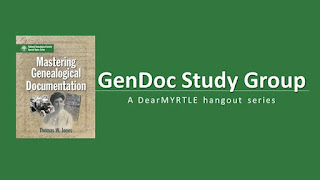Mastering
Genealogical Documentation Study Group
Chapter
Three – Citation Settings, Forms, and Shortcuts
Marceline
Beem
Reference:
Jones,
Thomas W. "Citation Settings, Forms, and Shortcuts." In Mastering Genealogical Documentation, 25-36.
Arlington, VA: National Genealogical Society, 2017.
This
week’s focus is on the three types of citations and when to use them: full citations, shortened citations, and
reference notes. As discussed last week,
genealogists use footnotes or endnotes to provide citations. Since footnotes are the most preferred
layout, I’ll use that term in the following discussion, but the same principals
apply to endnotes as well.
The
first time a source is used, the footnote would use a full citation. This
citation answers the following questions:
Who
said it?
In
what (source) did they say it?
When
did they say it?
Where
is that source located?
After
the first citation of a specific source, following references to it may use a
shortened version to preserve space. The
abbreviated source should contain enough information to remind the reader of
what source is being referenced. To that
end, the shortened citation may answer only the first two questions.
Full
reference notes are rarely used in proof statements, proof arguments, or other
family narratives, but they would be used in bibliographies or other “works
cited” formats (i.e., in a syllabus for a webinar or workshop).
This
week I am writing a family sketch about my great-grandmother, Frances Horton
Wallace Beem (1879-1846). I will share one
fact and the sources I am using, and show how I constructed each of the three
citation types for these sources.
Interview
Frances
and her first husband, Charles Wallace, had a daughter named Edith, who was
born in 1899 and died in 1902. I first
learned of Edith from my great-aunt, Nella Beem Critchett, who I interviewed by
phone when I first started researching in the late 1990’s. Unfortunately, I no longer have those notes,
and do not have the date I interviewed her (I lost the notes in one of several moves,
and this was not yet sourced in my database files when I lost the notes). The
citation for this interview follows, and is based on Evidence Explained (first
edition):
Reference
Note
Critchett,
Nella (Beem). Bend, Deschutes, Oregon. Interview by Marceline Beem, n.d. Handwritten notes. Privately held by interviewer, but notes were
lost in 2001.
Full Citation
Nella
(Beem) Critchett, daughter of Frances Horton Wallace Beem, (Bend, Deschutes, Oregon),
phone interview by Marceline Beem, n.d.; interview notes privately held by
interviewer until they were lost in 2001.
Short
Citation
Nella
(Beem) Critchett, phone interview, n.d.
My
aunt was the youngest of Frances’ children, born in 1916, so she never knew her
older half-sister. To meet GPS
standards, I should have other evidence to support Aunt Nell’s statements. Tennessee
did not record birth or death certificates during Edith’s short life, but
fortunately, there are two other sources which support my great-grandmother’s
memories of her young daughter, which she passed on to my aunt: the 1900 census
and Edith’s tombstone.
 |
| Figure 1. 1900 Census Listing for the Charles Wallace Family |
Abstract
Wallace,
Charles, head, b. June 1875, age 25, married two years
Frances,
wife, b. Jan 1879, married two years, age 21, mother of one child (one living)
Edith,
daughter, b. 1899 (month faded), age 10 months
Reference Note
Tennessee. Anderson County. 1900 U.S. census, population schedule. NARA microfilm publication T623, roll 1557. Washington, D.C.: Natonal Archives and Records Administration, n.d.
Full Citation
1900
U.S census, Anderson County, Tennessee, population schedule, 5th Civil
District, Enumeration District [ED] 5, p. 7B (penned), dwelling 138,
family 140, Charles Wallace; digital images, Ancestry.com (http://www.ancestry.com : accessed 24 September 2017);
citing National Archives microfilm publication T623, roll 1557.
Short
Citation
1900 U.S census, Anderson Co., Tenn., pop. sch., ED 5, p. 7B,
Charles Wallace.
Edith
was buried in Leach Cemetery. A picture of the tombstone is on Find A Grave.
Transcript:
Edith
Wallace
Born
July
30, 1899
Died
June
15, 1902
Reference Note
Find A Grave. Leach Cemetery (Anderson County, Tennessee). Database and digital images. (http://www.findagrave.com : 2017).
Full Citation
Find
a Grave, Leach Cemetery (Anderson
County, Tennessee), database and digital images (http://www.findagrave.com : accessed 23
Sep 2017), gravestone for Edith Wallace (1899-1902), memorial #12453839, created
by Pat Lacy, November 22, 2005.
Short
Citation
Find
a Grave, Leach Cemetery (Anderson Co., Tenn.), database and
digital images, gravestone for Edith Wallace (1899-1902).





